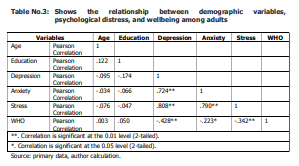Indian Journal of Health Social Work
(UGC Care List Journal)
Psychological Distress and Well-Being: A Cross-sectional Study of Adults in Asansol
Moumee Jesmin1, & Shaurya Prakash2
1 Development Practitioner, EHSAAS- Feel the Desire of Nature and Society, Mithani, Asansol, West Bengal,2 Assistant Professor, Gopal Narayan Singh University, Jamuhar, Sasaram, Bihar & Research Scholar, Department of Social Work, Visva-Bharati, Santiniketan, West Bengal
Correspondence: Shaurya Prakash, e-mail id: sauryap75@gmail.com
ABSTRACT
Background: A generic phrase used to describe unpleasant feelings or emotions that affect a person’s level of functioning is psychological distress. Health, pleasure, and affluence are perceived as indicators of well-being status. It entails having a positive outlook on life, feeling fulfilled in your work and relationships, and being able to handle stress. Aim: To examine the relationship between psychological distress and the Well-Being status of adults in Asansol, West Bengal. Materials and Methods: A cross-sectional study following quantitative research approach conducted in Asansol, West Bengal. The researchers adopted simple random sampling to reach the respondents. The data was collected using DASS and World Health Organization-Five WellBeing Index. Results and Conclusion: A more or less equal proportion of male and female respondents were found in the study sample. Only 13% of the adults were married, and the remaining 87% were unmarried. The findings of the study reveals that there is no significant age variation among the male and female adult respondents on the basis of age pattern. There is no gender difference on the basis of educational status among male and female respondents. If we look at the depression status, there is a significant gender variation that exists among the male and female respondents. On the basis of anxiety level, there is a slight variation between male and female respondents; females have more anxiety than male adult respondents. Stress levels differ significantly between male and female respondents, with females being more stressed than male adult respondents.
Keywords: Psychological distress, well-being, adult..
The current study’s objective is to examine the relationship between psychological distress and the Well-Being status of adults in Asansol, West Bengal.
- To ascertain the relationship between demographic factors such as age and gender on psychological distress and well-being of adults.
- To explore the relationship between psychological distress and well-being status of adults in some areas of Asansol, West Bengal.
- There wi ll be a strong inverse correlation between psychological distress and the well-being status of adults.
- There won’t be much of a gender difference in psychological distress and well-being among adults.
Adult: Unless prohibited by national law, someone older than 19 is considered an adult. (WHO) In the present study, we are taking adults between the age group of 20–35 years old.
Random sampling will be applied in this investigation. An individual who belongs to the age group of 20–40 years of age and lives in West Bengal will be taken. The researcher will reach and complete the psychological survey through Google Form. A total of 100 adults will be included for the present study.
In the present study, an attempt is made to find out the rel ationship between psychological distress and well-being of adults due to the global pandemic, thus following a correlational research design.
The following tools will be used for the research:
The data was analysed using IBM SPSS Statistics 16. A descriptive analysis and Pearson’s correlation will be used to test the hypothesis.
 On the basis of gender, a more or less equal proportion of male (51%) and female (49%) respondents were found in the study sample. If we look at the marital status of the respondents, then only 13% of the adults
On the basis of gender, a more or less equal proportion of male (51%) and female (49%) respondents were found in the study sample. If we look at the marital status of the respondents, then only 13% of the adults
were married and the remaining 87% were unmarried. All of the respondents are between the 12th and M levels of education. A maximum of three of them can be thirdyear grad or first-year master’s students. The average age of the adult respondents is 25; the minimum age is 18; and the maximum age of the adult respondents is 61. If we look at the age pattern of the adult respondents, we found that 45% and 48% of the respondents belong to the (18–24) and (25–30) age group respectively. The remaining 7% are more than 30 age group respondents.
 From the result of the independent t test, we can say that age is strongly associated and varied with psychological distress and wellbeing of the adult respondents. The adult respondents’ educational status does not have a significant association or variation with psychological distress and wellbeing. The respondents’ depression status was also significantly associated and varied among the respondents. Anxiety levels do not show significant variation among the adult respondents. Stress levels also showed significant variation and association among
From the result of the independent t test, we can say that age is strongly associated and varied with psychological distress and wellbeing of the adult respondents. The adult respondents’ educational status does not have a significant association or variation with psychological distress and wellbeing. The respondents’ depression status was also significantly associated and varied among the respondents. Anxiety levels do not show significant variation among the adult respondents. Stress levels also showed significant variation and association among
the adult respondents. If we see the WHO well-being status among the respondents, there is a strong association and variation among the respondents.
 From the Pearson correlation table, we can say that age and education have a positive relationship (.122). With increasing age, educational status seems to improve among the adult respondents. There is a negative relationship between increasing age and the level of depression (-.095), anxiety (-.034), and stress (-.076) among adult respondents, implying that with increasing age comes a lower risk of depression, anxiety, and stress. The WHO wellbeing status (.003) seems to be improving with increasing age. That shows the positive relationship between age and wellbeing status for adult respondents. If we
try to analyse the co-relation between educational status and psychological stress and well-being, it is found that with increasing educational status there is a lower prevalence of depression (-.174), anxiety (-.066) and stress (-.067) as all the variables have a
negative relationship with educational level.
The WHO wellbeing status (0.50) has a
positive relationship with the educational level
among adults. If we see the correlation
between stress (.808) and anxiety (.724) with
depression, it shows a strong positive
relationship. That means with increasing
stress and anxiety, the prevalence of
depression also increases. There is a negative
correlation between WHO well-being status
(-0.424) and depression among the adult
respondents. As a result, highly depressed
people have less well-being in life. There is a
strong positive co-relationship between
anxiety and stress (.790) among the adult
respondents. That means, with increasing
stress, the level of anxiety also increases.
Finally, there is a negative correlation between
stress and the WHO well-being status (-
0.3244) of adult respondents. As a result,
highly stressed people have less well-being
in life.
From the Pearson correlation table, we can say that age and education have a positive relationship (.122). With increasing age, educational status seems to improve among the adult respondents. There is a negative relationship between increasing age and the level of depression (-.095), anxiety (-.034), and stress (-.076) among adult respondents, implying that with increasing age comes a lower risk of depression, anxiety, and stress. The WHO wellbeing status (.003) seems to be improving with increasing age. That shows the positive relationship between age and wellbeing status for adult respondents. If we
try to analyse the co-relation between educational status and psychological stress and well-being, it is found that with increasing educational status there is a lower prevalence of depression (-.174), anxiety (-.066) and stress (-.067) as all the variables have a
negative relationship with educational level.
The WHO wellbeing status (0.50) has a
positive relationship with the educational level
among adults. If we see the correlation
between stress (.808) and anxiety (.724) with
depression, it shows a strong positive
relationship. That means with increasing
stress and anxiety, the prevalence of
depression also increases. There is a negative
correlation between WHO well-being status
(-0.424) and depression among the adult
respondents. As a result, highly depressed
people have less well-being in life. There is a
strong positive co-relationship between
anxiety and stress (.790) among the adult
respondents. That means, with increasing
stress, the level of anxiety also increases.
Finally, there is a negative correlation between
stress and the WHO well-being status (-
0.3244) of adult respondents. As a result,
highly stressed people have less well-being
in life.  From the statistical table, we can say that there is no significant age variation exists among the male (mean = 26) and female (mean = 25) adult respondents on the basis of age pattern. There is no gender difference on the basis of educational status among male (mean = 16) and female (mean = 16) respondents. If we look at the depression status, there is a significant gender variation that exists among the male (mean = 4.4) and female (mean = 6.1) respondents. On the basis of anxiety level, there is a slight variation between male (mean = 4.5) and female (mean = 4.7) respondents. The stress level shows a significant level of gender differences among male (mean = 5.4) and female (mean = 6.7) respondents. Gender differences also exist on the basis of the WHO well-being scale among male (mean = 4.7) and female (mean = 4.7) respondents.
From the statistical table, we can say that there is no significant age variation exists among the male (mean = 26) and female (mean = 25) adult respondents on the basis of age pattern. There is no gender difference on the basis of educational status among male (mean = 16) and female (mean = 16) respondents. If we look at the depression status, there is a significant gender variation that exists among the male (mean = 4.4) and female (mean = 6.1) respondents. On the basis of anxiety level, there is a slight variation between male (mean = 4.5) and female (mean = 4.7) respondents. The stress level shows a significant level of gender differences among male (mean = 5.4) and female (mean = 6.7) respondents. Gender differences also exist on the basis of the WHO well-being scale among male (mean = 4.7) and female (mean = 4.7) respondents.
Role of funding source: None

ISSN: 2582-1393 (online)
UGC Care List Journal

